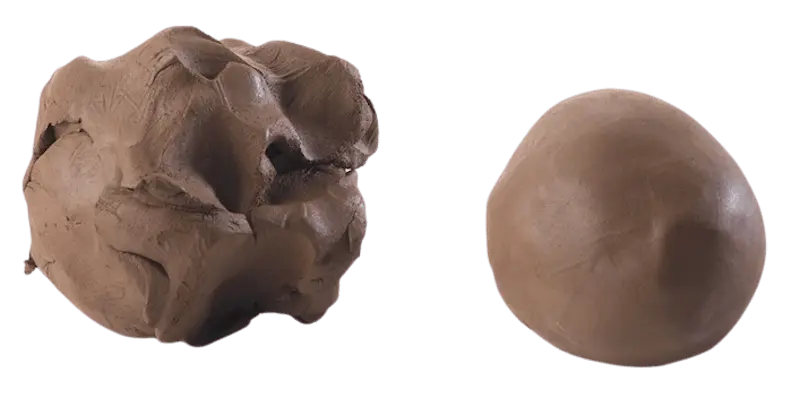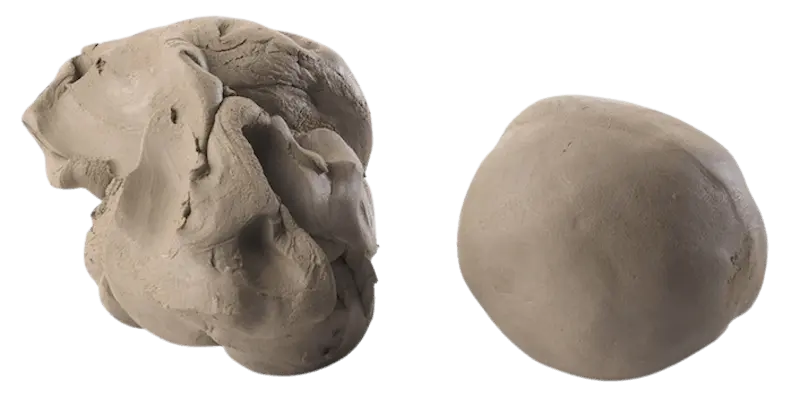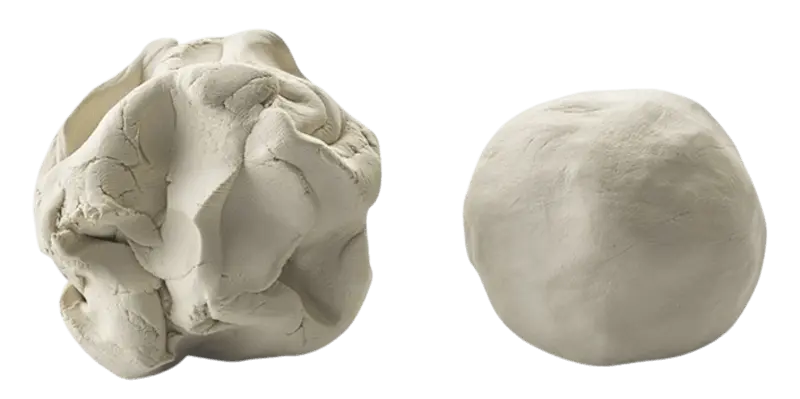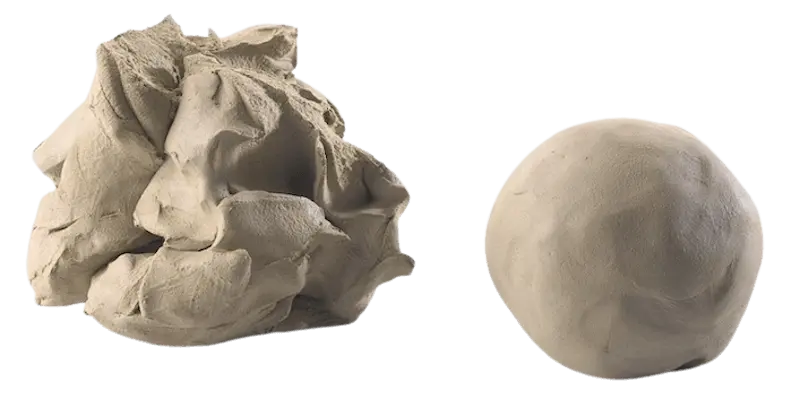If you’re a beginner at pottery, the first thing you’ll need to learn is what types of clay are available to you. That’s right – all clay is not the same! In this article, we’ll discuss the 4 different types of clay for pottery and how each type of clay feels to work with and how it differs from the others.
The truth is that the clay you use makes a big difference in the texture, color, and even the flexibility of the final product. However, when a specific outcome is what you want, isn’t it always? – that’s when you realize that you have to be careful in choosing the right type of clay. Otherwise, your time and effort will all be for naught.
What Are the 4 Types of Clay for Pottery?
When it comes to the different types of clay, you have an option between the types of clay that are described below:
1. Earthenware Clay
When people think of clay used in pottery, they usually think of this type. It is a very common and popular type of clay that is beginner-friendly, mainly because of its excellent plasticity.
Each type of earthenware clay will be slightly different because the soil, climate, and exact location of where the clay was mined all make a big difference in what it looks and feels like when you’re done. Nevertheless, earthenware clay is easy to work with and manipulate.


Let’s take a look at some of the characteristics of earthenware clay.
Uses of Eartheware Clay
Earthenware clay is used for basic sculpting purposes and wheel-throwing and hand-building projects. With earthenware clay, you can create beautiful flowerpots, bowls and containers, outdoor items, and all different types of sculptures. Because of its versatility, earthenware clay is a very popular choice for beginning potters.
Firing Earthenware Clay
Earthenware clay fires at very low temperatures compared to other clay types, yet the pottery pieces still get as hard as they should. Usually, the clay will fire at 1,945 degrees Fahrenheit (Cone 04) to around 1,828 degrees (Cone 06). Once the firing is complete, the product is non-vitreous, which means it is porous.
Because of this, whatever you make will absorb roughly 7% or more water or moisture. This type of pottery piece is a tad soft and can become scratched by sharp objects, which is something to keep in mind before you choose this type of clay.
Color of Earthenware
Earthenware clay usually comes in warm colors. When it’s wet, you might see some brown, orange, grey, or even some red, and you could see the same colors and possibly white after it’s been fired. As a general rule, pottery pieces show off their colors much better after they’ve been fired, with terracotta being the most popular color produced. Even better, earthenware products are easy to decorate with various glazes and paints.
2. Stoneware Clay
While stoneware clay is ball clay-based and not kaolin-based, it is moderate in hardness, plasticity, and porosity. In addition, it has stone-like qualities, which is one of the reasons for its name.


Uses of Stoneware Clay
Stoneware clay is easy to work with and can be painted with glazes, underglazes, overglazes, and even enamels and others. Because of this, this type of clay is a popular option when people want to make different types of tableware. Its main uses as far as techniques include wheel-throwing and hand-building of pottery pieces.
Firing Stoneware Clay
You’ll be firing at very high temperatures with stoneware clay – usually anywhere from 2,167 degrees Fahrenheit (Cone 5) to 2,345 degrees (Cone 10). Often, people add a type of refractory clay called fire clay to their stoneware clay project.
Fire clay is resistant to heat and therefore increases the temperature at which stoneware clay matures. Unfortunately, it also adds some roughness to the project because it can contain mineral impurities such as iron. That iron can also leave black spots on the pottery piece after you fire it, giving it a unique and elegant look.
Color of Stoneware Clay
Stoneware clay can vary in color and include grey, white, and even brown when wet. These types of clay contain tiny quantities of quartz and mica, as well as kaolinite, illite, and smectite. Because of its characteristics, stoneware clay can end up in various colors depending on the temperature and type of firing you use.
3. Porcelain Clay
Porcelain clay’s main ingredient used is a mineral known as kaolin, which is also called China clay. However, other materials are also used, which is why you can use this type of clay to make many items.


Uses of Porcelain Clay
Porcelain clays have very little plasticity and are, therefore, rather difficult to work with. Still, they can be used in cast slipping and wheel throwing to create pieces such as vases and tableware, among other very decorative items.
As a general rule, kaolin clay is mixed with various minerals so that its firing temperature is lower and its workability is increased. As a result, the clay typically fires at very high temperatures.
Color of Porcelain
The colors in this type of clay vary a lot, but all of them are light and subtle, which is one of the many reasons it is used in all types of porcelain and china objects. At the greenware stage, the color is a light grey-like tone, while the color turns white or off-white after the clay has been fired.
You can also apply enamels and porcelain glazes to kaolin clay only for the purpose of adding a little color to it. You also won’t need any glazing for the item to repel water, which is a feature many people like.
Types of Porcelain Clay
There are also three main types of kaolin clay or porcelain, and they include the following:
- Hard-paste porcelain is also called true porcelain. This is the most common type of porcelain and contains added minerals, usually either mica or feldspar. Hard-paste porcelain has to be fired at around 2,345 degrees Fahrenheit (Cone 10), but it creates a very sturdy object.
- Soft-paste porcelain is the least common type of porcelain. It is fired at lower temperatures of around 2,167 degrees Fahrenheit (Cone 5), and it is considered a weak type of porcelain. Kaolin is usually mixed with quartz, glass, bone ash, and even soapstone, and sometimes a little ball clay is added to the mix.
- Bone china is very strong, has a lot of strength, and is resistant to nicks and chips. Once you’re done, bone china usually has a translucent or whitish look. Bone china usually contains kaolin, feldspar, bone ash, and phosphates.
4. Ball Clay
When it comes to plasticity, each type of clay is a little different, and ball clays are the most plastic of them all. This is because ball clay has very few mineral impurities, a large percentage of quartz and kaolinite, and 10-25% mica.


This is a type of clay that occurs naturally as deposits or settlements that have very fine minerals in them. As a result, materials such as lignite and others are frequently found in ball clays.
Uses of Ball Clay
Ball clay has a lot of binding quality and is very plastic; because of this, it is used frequently to make vases, toilet bowls, floor tiles, and all sorts of tableware. You cannot use ball clay by itself because it is slippery and very fine, but it is frequently added to other clay bodies and in slip casting. You can also use it for wheel-throwing, which is less common than the other two.
Firing Ball Clay
Ball clay will harden once you fire it around 2,345 degrees Fahrenheit (Cone 10). The main disadvantage of ball clay is that it shrinks quite a bit during the firing process, which is another reason you can’t use this type of clay on its own.
However, if you are experienced enough or you have a very large kiln, you might be able to make your product without a lot of shrinking. For the most part, ball clay always works best with other clays, such as earthenware or stoneware clay.
Color of Ball Clay
When you fire ball clay, it loses some of its color. In fact, at the greenware stage, ball clay is usually grey in color. Once you fire ball clay, it changes to a light buff color, but when you fire it just right, it produces a nice white color, which is why it is such a popular choice among potters.
Types of Clay for Pottery
As a recap, there are four types of clay, but generally, only three of them are used in pottery. Since stoneware clay is easier to use than the other types, this is recommended for beginners in ceramics.
It can be fired more than once and is perfect for making various objects, including large vases, small plates, and much more. In addition, stoneware clay is durable, strong, and non-porous, so you can put liquid in it afterward without glazing it.
The second type of clay used for pottery is earthenware clay, which is heavier and thicker than stoneware but also a little weaker. Terracotta, familiar to almost everyone, is the most common and recognizable type of earthenware clay.
Since items made from earthenware clay are porous, they cannot hold any kind of liquid. You can change that, however, if you glaze the objects and fire them a second time, but that isn’t always practical for beginners.
Finally, the third type of pottery clay is porcelain clay, which is softer but more flexible than the other types of clay. In fact, porcelain clay is so soft that it can be difficult to shape. You also have to use the right amount of water because if you don’t, the item will dry out, while adding too much water can cause the item to lose its shape and maybe even fall apart.


These things being said, porcelain pottery is gorgeous, even though it isn’t the best clay to work with if you’re a beginner.
And just in case you’re wondering, all three of these clay types are suitable for use on pottery wheels. Some are easier to shape than others, but all are good for wheel-throwing. Of course, each has pros and cons, but if you keep all of these things in mind, it can be easier to decide which type of clay is right for you.
The Physical Properties of Clay
When you’re deciding on the right type of pottery clay for your next project, it’s much easier if you’re familiar with some of the terms related to different types of clay. Clays have characteristics you’ll want to research before buying the right kind, and below are some terms to help you make that decision.
Absorption
Pottery clay always has an absorption percentage, which is the amount of water a piece that’s already been fired absorbs relative to its own weight. Most clays’ absorption rate ranges from 0% to 15%.
Ceramic
The word “ceramic” doesn’t just describe the items in your kitchen cabinets. Literally, the term refers to any solid sculpted item made out of clay that has lost its plasticity after it is fired.
Ceramics are hard but brittle objects, but they are also corrosion-resistant. When you fire the clay, it will release some gases, lose the water it’s retained, melt just a tiny bit, and most importantly, form strong bonds among all its particles.
Firing Temperature
Also called the temperature range, this refers to the temperature required for the piece to reach its maturity. In other words, the firing range tells you the range you need to fire your pottery piece for it to be completed.
The temperatures and the time required by the pieces when being fired usually vary, depending on the size or thickness of the piece and the type of clay you use. And much like the name implies, most pieces recommend a temperature range and not one specific temperature.
Grog
Grog is clay that has been fired, then crushed into an almost powder-like substance. The particle sizes can vary, but generally, grog is added to the clay to change the texture or even reduce the amount of shrinkage that occurs.
You can buy grog already mixed in with the clay, or you can buy these two items separately and then mix them together yourself. Try mixing them together yourself with different grog and clay for a totally unique look.
Plasticity
Plasticity is a term that is easy to understand. It merely refers to the flexibility of the clay and its potential for you to mold it into the shape you want. Pottery is often called plastic arts because it involves clay or other plastic mediums being made into items such as sculptures and ceramics.
The plasticity of the clay will depend on its ability to retain water and the size of its particles. Once you fire a specific item made of clay, its elasticity wears off.
Shrinkage
Clay usually shrinks when it dries, so they automatically become a little smaller once they go through the firing process. Most items shrink 5-15%, depending on the type of clay you use. If you use the same type of clay for specific projects, it’s easy to learn how much shrinkage will occur in that particular clay type.
What Compounds are Found in Clay?
When researching the different types of clay, it’s also good to know about the various compounds found in the clays. These can include the following:
Chlorite
Chlorite is a compound that contains minerals such as magnesium, iron, zinc, manganese, lithium, nickel, and calcium. The amounts of each of these minerals can vary depending on the chlorite itself. Although chlorite is not considered a clay compound, it can still be found in some types of clay as a mineral.
Illite
Illite is a material that contains aluminum, silicon, magnesium, iron, and potassium. Sometimes it also contains chromium and sodium. It is found as very small particles, which is unlike any other clay minerals, and it’s a very rocky compound.
Kaolinite
Kaolinite is soft and earthy with a white color and is found in all types of clay. It is both inelastic but very flexible, and in some parts of the world, it has a color that resembles rust. It is also a silicate compound.
Smectite
When clay minerals contain different amounts of alkaline earth metals and alkali metals, this is known as smectite. These minerals allow clay objects to absorb water better so that they can expand.
Conclusion
While there are four different clay types, only three are generally used in pottery: Stoneware Clay, Earthenware Clay, and Porcelain Clay, also known as ceramic.
Each type has its own advantages and disadvantages, but keep in mind that earthenware clay is best for beginners, while Porcelain clay is better for more experienced potters.
In addition, some are harder to work with than others, which is why researching the different types of clay should be done first before you decide which one is right for you.



Enter your email below to get our FREE beginner friendly tips.
By entering your email address you agree to receive emails from Potters Passion. We'll respect your privacy and you can unsubscribe at any time.
